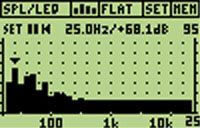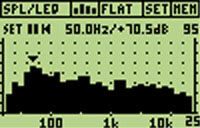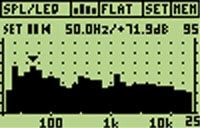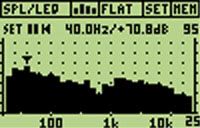Boring audio measurement, Part 1
#1
VP Electricity
Thread Starter
Join Date: Jun 2004
Location: Portland OR US
Age: 58
Posts: 4,617
Likes: 0
Received 8 Likes
on
1 Post
Boring audio measurement, Part 1
OK, I had a busy weekend - we bought a home thater setup and had to wire and setup everything in the basement, and I also got to use my new audio test analyzer a bit with a stock TSX, courtesy of iokua, who was very cool and let me test in his car and mine for a bit and hang out. Thanks, man, very much appreciated!
OK, so I have this handheld audio analyzer and a calibrated mic and some other gear, lots of it is for pro applications that I won't relate or often use, but basically what it does is allow test tones to be played through a speaker system or on a cable and measure the result. For instance, you can play a test tone called "pink noise", which sounds like static but is actually pseudorandom signals that are equal in energy at each octave - they get slightly hotter as you go up in frequency, so that's where "pink" comes from. (Noise that is equal at each frequency is called "white" noise - pink noise approximates how we hear better than white, but anyway...)
So this analyzer lets you determine if a system plays sound at a particular note. It does not tell you how a system sounds, or where it distorts, or if it sounds real, or if the stereo image is working. All it does is look at notes and say if they are even, quieter than the rest, or louder than the rest. This can help diagnose some problems, but won't help with others. Our ears are more accurate but less precise - we can discren more problems, but won't neccesarily be able to quantify them well.
This analyzer will measure distortion too, and I really want to do that with a stock system at medium and higher volumes, but the manual assumes that you will only measure distortion with the signal generator, not with a CD (they say I can but I don't know how to get the reference signal in yet..). I could use the AUX input, and iokua has an AUX in for an iPod, so I should have done it, but I wasn't feeling like I knew how to do it quite yet, so it will have to wait for another day... sorry. This is a very important measurement because a lot of the shortcoming of a factory system is how it sounds when you play it louder (esp. with windows and sunroof open!) and the speakers break up a bit and the amp runs out of clean power and starts clipping.
Anyway, first I measured our TSX (5AT stock 'cept for audio) parked and idling. There was one person in the car and the mike was about at the passenger's headrest. I got this:

That peak down in the bass is like 14dB above the rest, and it's at 25 Hz. Whenever we test a system with the engine running, this peak is visible. Another demonstration that car stereos need more bass so they sound right.
I would like to get measurements of the car on the highway at speed someday so we know what it sounds like, but we didn't do that on Sunday either... I know that the 17"s spinning will further cause a bass hump to overcome.
This graph is the factory system with the car off.

The rolloff in the low bass is obvious. The system has a spike at 50 and then drops hard. There is also a 5dB drop at 160 that is heard as a midbass hole, and an 8 dB drop at 1K and a corresponding spike at 1.2-1.6K of about 6 dB. Not sure why this is exactly, but more on that later. There is about an 8dB rolloff at the top end that is not unexpected.
The same stock system with the car running looked like this (for this test we had two people inside, and I don't know for sure how much that skewed things:

The spike at 25 Hz is obvious. Since we know the stock system has nothing down at 25 Hz, and we know the car is noisy there, we know where that sound comes from.
The spikes at 125 Hz and 1.2K or 1.6 K are still present. The holes at 200 hz and 1K or just below that are still present as well.
OK, now for comparison here are two curves from my car. Not that this is a perfect curve, but just for illustration. Ths system is 2 rear 6x9 woofers, 2 front door Scan Speak 5.25s, two dash Scan Speak tweeters, the Alpine-made crossovers than came with these Alpine-rebranded 2003 X-series SPX-F13M center-channel kits, and a JL 300/4 74 watt by four amp running in 4-channel mode. The fronts are crossed over at about 65 and the rear woofs at about the same.
This one is with the engine off:

This one is with the engine on:

There is still a spike at 50 Hz (resonance of the rear deck? : ) but it is minimal compared to the sound around it - it's smooth and even. 20 Hz drops about 8dB, which is expected with a 6x9 woofer.
There is an ~8dB hole about 500-630 Hz. Lower than the stock system's hole. Not sure why this is precisely - just an anomaly of the car. I would be interested in trying reversing polarity on both door mids and seeing what happens - low-percentage shot, but what the heck. This hole could make the mids a bit more distant than they need be with vocals.
There is about a 6dB rolloff at the treble (please note I am looking at the text output for these measurements, not at the charts. I pasted the text below, let's see if it comes out right... Edit - no, they didn't, deleting...) These tweeters are on their lowest output settings and I still haven't changed their xover taps, so that might change slightly.
Overall, this curve looks fairly uniform, and has one issue to fix in the 500-630 range. A good EQ could do that...
I should have tried SPL measurement but I didn't want to blow anything in the stock system. The stock system definitely can go louder than mine, but it doesn't sound bery good.
OK, so I have this handheld audio analyzer and a calibrated mic and some other gear, lots of it is for pro applications that I won't relate or often use, but basically what it does is allow test tones to be played through a speaker system or on a cable and measure the result. For instance, you can play a test tone called "pink noise", which sounds like static but is actually pseudorandom signals that are equal in energy at each octave - they get slightly hotter as you go up in frequency, so that's where "pink" comes from. (Noise that is equal at each frequency is called "white" noise - pink noise approximates how we hear better than white, but anyway...)
So this analyzer lets you determine if a system plays sound at a particular note. It does not tell you how a system sounds, or where it distorts, or if it sounds real, or if the stereo image is working. All it does is look at notes and say if they are even, quieter than the rest, or louder than the rest. This can help diagnose some problems, but won't help with others. Our ears are more accurate but less precise - we can discren more problems, but won't neccesarily be able to quantify them well.
This analyzer will measure distortion too, and I really want to do that with a stock system at medium and higher volumes, but the manual assumes that you will only measure distortion with the signal generator, not with a CD (they say I can but I don't know how to get the reference signal in yet..). I could use the AUX input, and iokua has an AUX in for an iPod, so I should have done it, but I wasn't feeling like I knew how to do it quite yet, so it will have to wait for another day... sorry. This is a very important measurement because a lot of the shortcoming of a factory system is how it sounds when you play it louder (esp. with windows and sunroof open!) and the speakers break up a bit and the amp runs out of clean power and starts clipping.
Anyway, first I measured our TSX (5AT stock 'cept for audio) parked and idling. There was one person in the car and the mike was about at the passenger's headrest. I got this:

That peak down in the bass is like 14dB above the rest, and it's at 25 Hz. Whenever we test a system with the engine running, this peak is visible. Another demonstration that car stereos need more bass so they sound right.
I would like to get measurements of the car on the highway at speed someday so we know what it sounds like, but we didn't do that on Sunday either... I know that the 17"s spinning will further cause a bass hump to overcome.
This graph is the factory system with the car off.

The rolloff in the low bass is obvious. The system has a spike at 50 and then drops hard. There is also a 5dB drop at 160 that is heard as a midbass hole, and an 8 dB drop at 1K and a corresponding spike at 1.2-1.6K of about 6 dB. Not sure why this is exactly, but more on that later. There is about an 8dB rolloff at the top end that is not unexpected.
The same stock system with the car running looked like this (for this test we had two people inside, and I don't know for sure how much that skewed things:

The spike at 25 Hz is obvious. Since we know the stock system has nothing down at 25 Hz, and we know the car is noisy there, we know where that sound comes from.
The spikes at 125 Hz and 1.2K or 1.6 K are still present. The holes at 200 hz and 1K or just below that are still present as well.
OK, now for comparison here are two curves from my car. Not that this is a perfect curve, but just for illustration. Ths system is 2 rear 6x9 woofers, 2 front door Scan Speak 5.25s, two dash Scan Speak tweeters, the Alpine-made crossovers than came with these Alpine-rebranded 2003 X-series SPX-F13M center-channel kits, and a JL 300/4 74 watt by four amp running in 4-channel mode. The fronts are crossed over at about 65 and the rear woofs at about the same.
This one is with the engine off:

This one is with the engine on:

There is still a spike at 50 Hz (resonance of the rear deck? : ) but it is minimal compared to the sound around it - it's smooth and even. 20 Hz drops about 8dB, which is expected with a 6x9 woofer.
There is an ~8dB hole about 500-630 Hz. Lower than the stock system's hole. Not sure why this is precisely - just an anomaly of the car. I would be interested in trying reversing polarity on both door mids and seeing what happens - low-percentage shot, but what the heck. This hole could make the mids a bit more distant than they need be with vocals.
There is about a 6dB rolloff at the treble (please note I am looking at the text output for these measurements, not at the charts. I pasted the text below, let's see if it comes out right... Edit - no, they didn't, deleting...) These tweeters are on their lowest output settings and I still haven't changed their xover taps, so that might change slightly.
Overall, this curve looks fairly uniform, and has one issue to fix in the 500-630 range. A good EQ could do that...
I should have tried SPL measurement but I didn't want to blow anything in the stock system. The stock system definitely can go louder than mine, but it doesn't sound bery good.
#2
Thanks! Nice system you've got installed - I haven't been keeping up on this board to notice you put in the Scan Speak's. I'm still cruising along happily with my MBQs front and rear, though I think my TSX is developing the passenger door rattle/buzz.
I know my TSX's rear deck resonates (and rattles at times) like crazy with those MBQ 6x9's back there - the installer that worked on my system recommended coming back some time to have it removed, reinforced and re-installed. There's that crazy rubber block in the middle (underneath) the rear deck that rattles - best guess is that it helped keep the deck from rattling with the stock speakers, but, with aftermarket, it becomes the rattle.
An EQ would definitely be a nice add-on to correct some of the color caused by the car itself as well as the stock HU.
I know my TSX's rear deck resonates (and rattles at times) like crazy with those MBQ 6x9's back there - the installer that worked on my system recommended coming back some time to have it removed, reinforced and re-installed. There's that crazy rubber block in the middle (underneath) the rear deck that rattles - best guess is that it helped keep the deck from rattling with the stock speakers, but, with aftermarket, it becomes the rattle.
An EQ would definitely be a nice add-on to correct some of the color caused by the car itself as well as the stock HU.
#4
VP Electricity
Thread Starter
Join Date: Jun 2004
Location: Portland OR US
Age: 58
Posts: 4,617
Likes: 0
Received 8 Likes
on
1 Post
Originally Posted by jaydub
Those look like the displays on a TI graphing calculator I've got. 

I wish I had done the distortion stuff... kicking myself now.
Thread
Thread Starter
Forum
Replies
Last Post
sockr1
Car Parts for Sale
22
10-01-2015 01:31 AM
DiamondJoeQuimby
Car Parts for Sale
1
09-10-2015 11:40 AM



